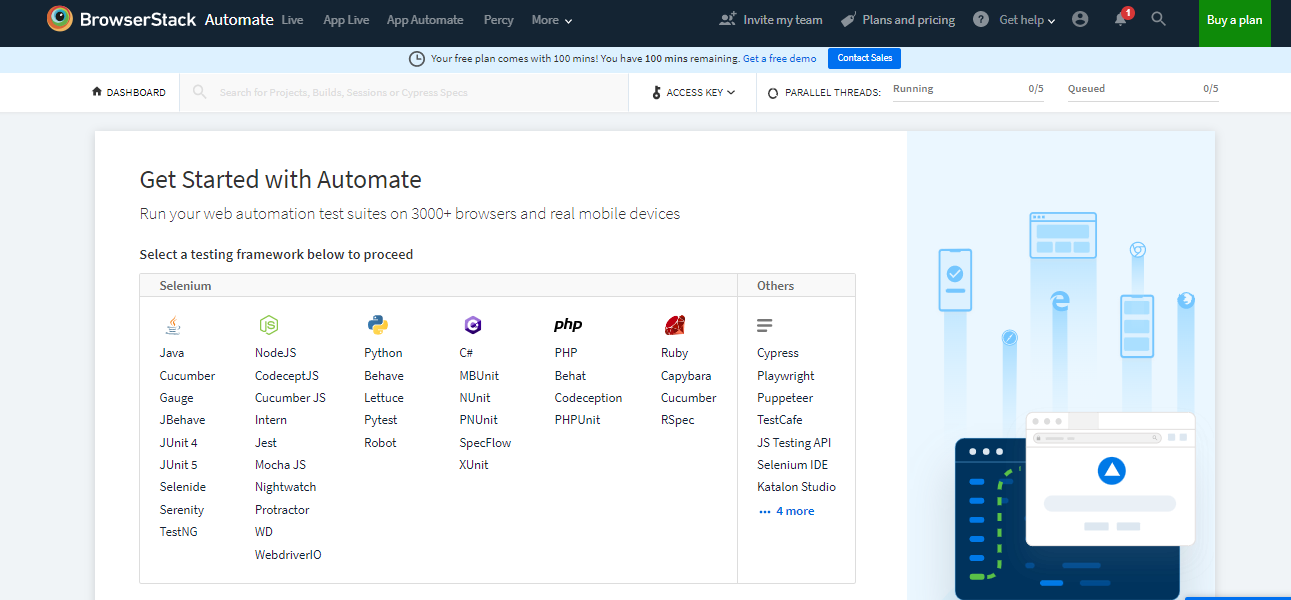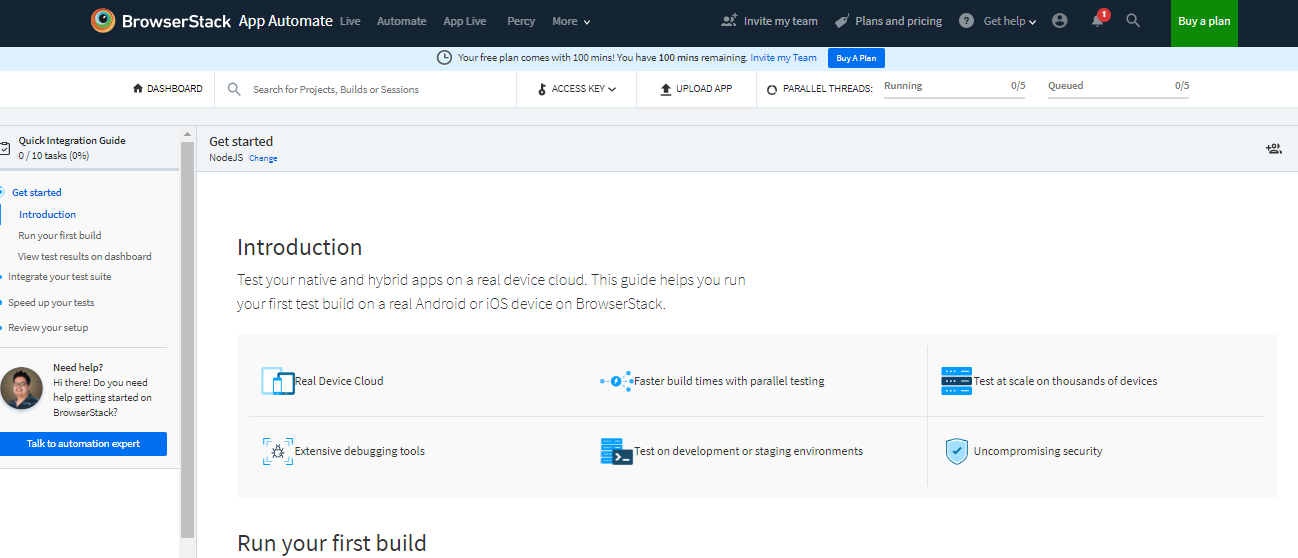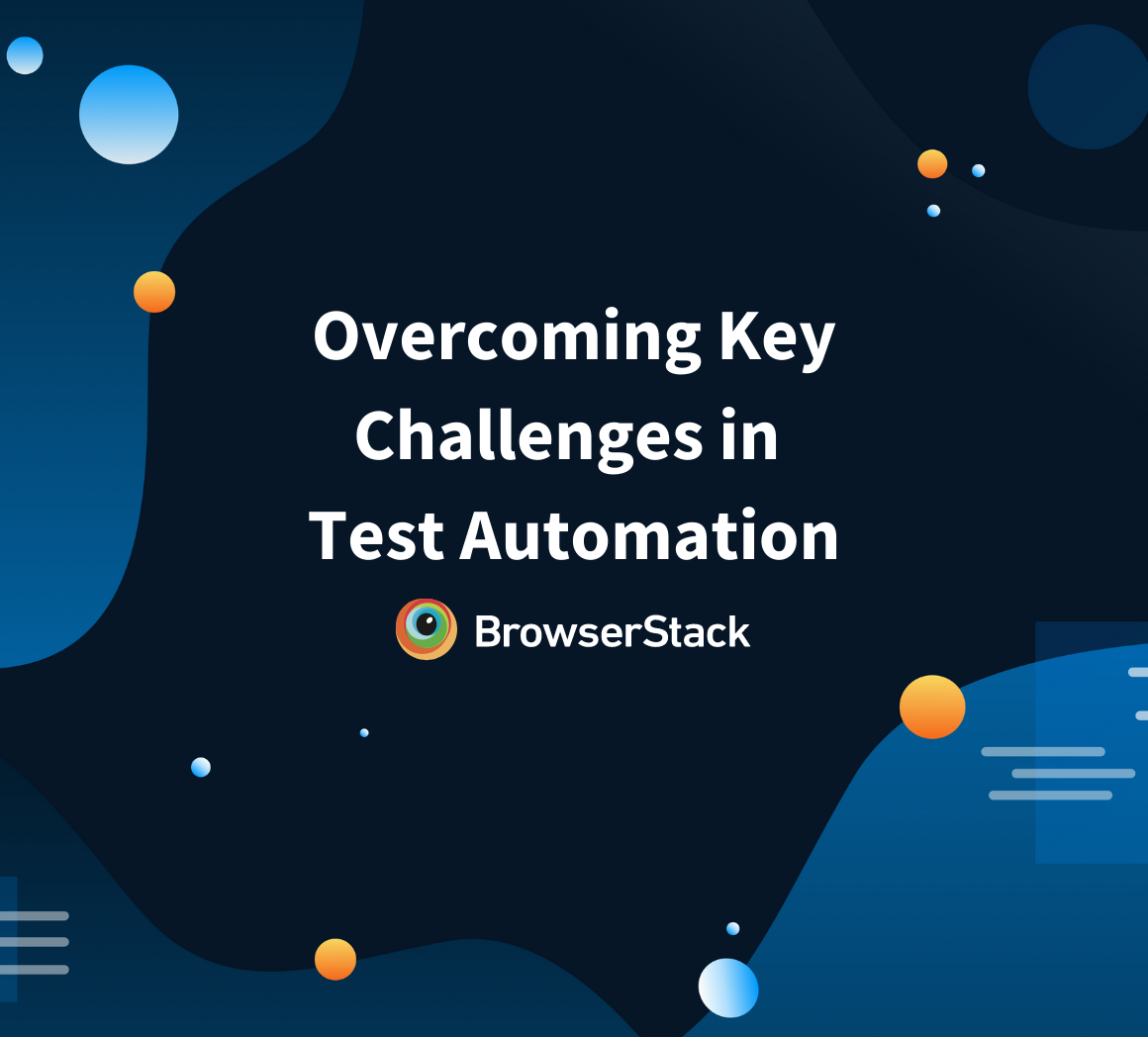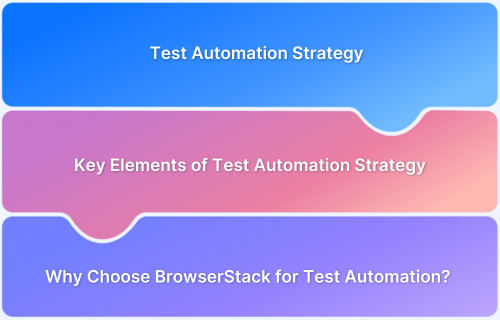Ensuring high-quality applications requires efficient and reliable testing processes in software development.
Overview
What is Test Automation?
Test automation is the use of software tools to execute tests, verify results, and handle repetitive testing tasks with minimal human intervention.
Key Benefits of Test Automation
- Faster Execution: Automated tests run significantly faster than manual testing.
- Improved Accuracy: Eliminates human errors by executing tests consistently.
- Enhanced Test Coverage: Allows testing across multiple platforms and environments.
- Cost Efficiency: Reduces long-term testing costs by minimizing manual effort.
- Early Bug Detection: Identifies defects early in development, preventing costly fixes.
- Better Resource Utilization: Frees testers to focus on complex scenarios instead of repetitive tasks.
Popular Test Automation Tools
- BrowserStack: Enables automated testing on real devices and browsers, ensuring accurate and reliable results.
- Selenium: For web application testing, supporting multiple languages and DevOps integrations.
- Appium: For automating native and hybrid mobile apps on Android and iOS.
- Jenkins: A CI/CD tool that automates testing, builds, and deployments for DevOps workflows.
- JUnit: A unit testing framework for Java applications, enabling automated unit and integration tests.
- TestNG: A Java testing framework supporting unit, integration, and functional testing.
- SoapUI: For automating API testing of SOAP and REST web services.
- Cucumber: A BDD tool that enables writing and automating tests in plain language across various programming languages.
This article explores the benefits, challenges, tools, and best practices of test automation, guiding teams in implementing effective strategies.
What is Test Automation?
Test automation uses software tools and scripts to execute tests, validate results, and streamline the testing process with minimal human intervention.
How is Test Automation different from Automation Testing?
While automation testing refers to executing tests automatically, test automation is the broader strategy of implementing automated testing within the software development lifecycle. Automation testing focuses on reducing manual effort by automating repetitive and time-consuming test cases while test automation is discipline that includes various processes, tools, and frameworks to optimize and scale software testing.
Test automation is widely used for various testing activities, including:
- Regression Testing: Ensures new code changes don’t break existing functionality.
- Functional Testing: Verifies that the application works as intended.
- Performance Testing: Assesses speed, stability, and scalability under load.
- Load Testing: Simulates multiple users to test system behavior.
Test automation improves accuracy, efficiency, and test coverage while reducing manual effort, making it essential for software development.
Types of Test Automation Frameworks:
Typically, there are four test automation suites or frameworks that are widely accepted while automating the apps:
- Keyword Driven Automation Framework
- Data-Driven Automation Framework
- Hybrid Automation Framework
- Modular Automation Framework
Why is Test Automation important?
Test automation is significant for several reasons:
- Enhanced Efficiency: Test automation can save a huge amount of time and effort by automating monotonous tasks and freeing up QA testers to focus on complicated and critical testing deeds.
- Quality Assurance: Test automation in software engineering can assist to ensure that software products meet essential quality standards by providing accurate and fast feedback on issues and defects, allowing test automation development teams to address them efficiently and rapidly.
- Improved Scalability – Automating your tests transforms the scale at which your test QA team operates as PCs can run tests 24 hours a day. This lets you run a lot more tests with similar resources.
- Increased Test Coverage: Automated tests can execute many test cases rapidly and accurately, allowing QA testers to cover an extensive range of scenarios and edge cases that might be hard to test manually.
- Reduced Time-to-Market: By automating testing, development teams can accelerate their launch/ release cycles and rapidly deliver top-quality products to market.
- Consistency and Cost-effective: Automated tests are implemented the same way every time, ensuring consistency. It can also be a lucrative way to test software products, as it lessens the related costs of maintaining a large testing team.
Why is Automation Testing core to DevOps?
Automation testing is core to DevOps for multiple reasons:
- Continuous Testing: In DevOps, testing is incorporated into every stage of the SDLC (software development lifecycle), from code development to deployment. Automated testing allows QA teams to test iteratively and constantly throughout the test automation development process, guaranteeing that software is of top quality at every stage.
- Collaboration: DevOps is all about collaboration between operations, development, and testing teams. Automated testing frameworks and tools can help enable this teamwork by providing a common language and series of tools that all teams can use.
- Scalability: As DevOps teams scale and the complexity of the software being developed raises, automated testing becomes vital to ensure that software is comprehensively tested and of high quality.
- Continuous Delivery: In DevOps, the goal is to deliver software reliably and quickly. Automated testing is essential to achieving this objective by ensuring that software is thoroughly tested before it is released, minimizing the risk of defects and issues in production.
- Detect bugs and Save time-Unlike manual testing. Automatic test cases easily detect bugs and make testing faster which means you can deploy products to market more rapidly.
- Security: Move quickly without compromising compliance and security by leveraging automated compliance policies, configuration management techniques, and fine-grained controls.
Popular Test Automation Tools
Here are some popular and commonly used test automation tools:
- Selenium: Selenium is an open-source automation testing tool widely used for web application testing. It supports various programming languages, including Java, Python, and C#. It can be integrated with many DevOps tools such as Jenkins, Docker, and Git.
- Appium: Appium is an open-source automation testing tool designed for mobile applications. Appium supports multiple mobile platforms, including Android and iOS, and allows the automation of both native and hybrid mobile applications.
- Jenkins: Jenkins is a popular open-source continuous integration and delivery tool. It can be used to automate testing, build, and deployment processes, making it an essential tool for DevOps.
- JUnit: JUnit is a popular open-source unit testing framework used for Java applications. JUnit supports automated testing of Java code, including unit tests and integration tests.
- TestNG: TestNG is a testing framework used for Java applications. It supports various types of tests, including unit, integration, and functional tests, and is widely used in DevOps.
- SoapUI: SoapUI is an open-source testing tool used for testing SOAP and REST web services. It allows testers to automate the testing of APIs and web services and supports various protocols, including HTTP, JMS, and JDBC.
- Cucumber: Cucumber is a popular open-source tool used for behavior-driven development (BDD). It allows testers to write tests in plain language and automate them using various programming languages, including Java, Ruby, and JavaScript.
No matter which framework you choose based on your project requirements, it is important to test on real devices and browsers so as to take real user conditions into account. This helps in getting more accurate test results. BrowserStack allows you to test on 3500+ real browsers over desktop and mobile devices for a comprehensive testing experience.
These are just a few examples of popular automation testing tools used in DevOps.
Requirements for DevOps in Automation Testing
To implement DevOps in test automation, various requirements must be met:
- Infrastructure as Code: To allow continuous testing, the infrastructure should be treated as code, and automated tools must be used to configure, provision, and manage the infrastructure.
- Automated Testing Framework: A scalable and robust test automation framework must be in place to automate the entire testing process.
- CI/CD (Continuous Integration and Delivery): CI/CD pipelines must be in place to automate the software delivery process, and counting testing.
- Collaboration and Communication: The DevOps testing team must work closely with the development & operations teams to detect and address issues quickly.
- Quality Assurance: Quality assurance must be integrated into the test automation process to guarantee that the software is of better quality and meets the requirements.
- Metrics and Monitoring: Metrics and monitoring must be in place to track the effectiveness of the testing process and detect areas for improvement.
How to Implement DevOps in Test Automation?
- Plan the automation testing strategy: The first stage in implementing DevOps in automation testing is to plan the testing strategy by identifying the testing necessities, choosing the appropriate tools, defining the test scenarios, and generating the automation test scripts.
- Build the CI/CD pipeline: The next step is to build a continuous integration and delivery pipeline that automates the testing, build, and deployment processes.
- Develop a test automation framework: Create a test automation framework that allows for easy scalability and maintenance. The framework must be based on the principles of reusability, modularity, and maintainability.
- Implement version control: Use a version control test automation system, such as Git, to manage the automated scripts and other testing artifacts. This allows the QA team to track modifications, collaborate, and maintain version control for the test scripts.
- Automate test data management: Test data management is vital in automation testing to guarantee that the test data is reliable, consistent, and up-to-date.
- Analyze the results: Use the reporting tools to analyze the results of the automated tests.
- Continuously improve the testing process: Continuously review and improve the testing process to identify areas for improvement.
Using Real Device Cloud for Test Automation
BrowserStack offers Automate and App Automate for automated web testing and mobile app testing. Here’s how each product aligns with test automation:
Run Automation Test on Real Devices for Free
- BrowserStack Automate is a web testing product that enables teams to run automated Selenium, Cypress, Puppeteer, and Playwright tests on a cloud-based infrastructure. It supports testing on over 3000 real mobile and desktop browsers and devices, providing a comprehensive testing environment for web applications.
- BrowserStack App Automate is a mobile testing product that enables teams to run automated Appium, XCUITest, and Espresso tests on a cloud-based infrastructure. It supports testing on over 3,500 real mobile devices and simulators, providing a comprehensive testing environment for mobile applications.
In terms of product alignment in test automation, both BrowserStack Automate and App Automate align with the principles of continuous testing and continuous delivery. They enable teams to test early and often, providing quick feedback on the quality of their web and mobile applications.
Advantages of Test Automation
Test automation proffers numerous benefits, which are discussed below:
- Speedy Tests: Automated testing is much quicker than manual testing, letting QA experts or testers test more scenarios in a shorter time.
- Increased Test Coverage: Automated testing can cover many test cases and scenarios, counting edge cases and negative tests that are tough to test manually.
- Consistency: Automated testing offers consistent and repeatable test outcomes, enhancing their reliability and accuracy.
- Cost-Efficient: Although setting up automated testing involves an initial cost, it is highly cost-efficient in the long run.
- Reusability: Automated test cases can be reused across multiple releases, guaranteeing that they are consistently and frequently tested over time.
Limitations of Test Automation
Here are some key limitations and challenges of test automation:
- Initial Cost: The initial cost of setting up test automation can be high, including the licenses, cost of tools, hardware, and personnel training.
- Maintenance Cost: Automated test cases necessitate ongoing efforts, such as updating scripts and fixing glitches, which can be costly.
- Complex Scenarios: Complicated scenarios and edge cases may be challenging to automate, requiring manual testing to guarantee complete coverage.
- False Positives & Negatives: Automated tests may produce false positives and negatives, requiring human intervention to confirm and validate the test outcomes.
- Limited Insight: Automated tests may provide restricted insight into the root cause of issues and may not detect defects related to usability.
Best Practices of Test Automation
Here are some best practices for test automation that can help to ensure success and efficiency:
- Test automation should be planned and designed with a clear objective.
- Automating the right test cases can save time
- Use a modular and scalable automation framework
- Ensure effective version control.
- Perform continuous testing throughout the development process.
- Integrate automation testing with other DevOps tools and processes
- Monitor and analyze test results
- Regularly review and update automation scripts
- Involve the entire team in automation testing
Read More: 10 Test Automation Best Practices to follow
Conclusion
Test automation is essential for improving software quality, accelerating testing cycles, and enabling seamless DevOps integration.
While it offers numerous benefits, such as efficiency, accuracy, and scalability, it also comes with challenges, such as high initial costs and maintenance. Choosing the right tools, following best practices, and leveraging a real device cloud like BrowserStack can maximize its effectiveness.
A well-structured test automation strategy ensures faster releases, better test coverage, and a seamless user experience.








